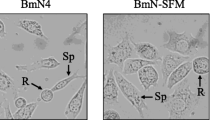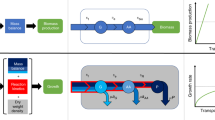Summary
The growth rate of spontaneously transformed BALB/3T3 cells is proportional to glutamine concentration between 50 and 400 μM, with little or no growth occurring in less than 50 μM glutamine. By contrast, nontransformed BALB/3T3 cells multiply, although slowly, with as little as 20 μM glutamine. Neither cell type depletes the medium of glutamine at the low concentrations. Cystine requirements of both cell types increase with serum concentration, probably due to the binding of half-cystine residues by the serum. Calf serum is a much more potent stimulator of cell multiplication than calf lymph, especially for the nontransformed cells. The rate of cell multiplication can be reduced by lowering the concentration of essential amino acids to the physiologic level found in body fluids, but the growth limitations can be fully compensated by simply raising the serum concentration. Growth factors may act by enhancing the utilization of amino acids, particularly of glutamine which is a required substrate for the first and chief regulatory steps of purine and pyrimidine synthesis. Lymph, which is coextensive with interstitial fluid in vivo, is poor in growth factors for the nontransformed BLAB/3T3 cells as well as for recently explanted mouse embryo cells, which raises questions of how normal cell growth is maintained in the body.
Similar content being viewed by others
References
Buchanan, J. M. The amidotransferases. In: Meister, A., ed. Adv. Enzymol. 39:91–183; 1973.
Eagle, H.; Oyama, V. I.; Piez, K. A. The reversible binding of half-cystine residues to serum protein, and its bearing on the cystine requirement of cultured mammalian cells. J. Biol. Chem. 235:1719–1726; 1960.
Gospodarowicz, D.; Delgado, D.; Vlodavsky, I. Permissive effect of the extracellular matrix on cell proliferation. Proc. Natl. Acad. Sci. USA 77:4094–4098; 1980.
Ham, R. G.; Hammond, S. L.; Miller, L. L. Critical adjustment of cystine and glutamine concentrations for improved clonal growth of WI-38 cells. In Vitro 13:1–10; 1977.
Jacobs, J. P. A simple medium for the propagation and maintenance of human diploid cell strains. Nature 210:100–101; 1966.
Kallinowski, F.; Runkel, S.; Fortmeyer, H. P., et al. Glutamine: a major substrate for tumor cells in vivo? J. Cancer Res. Clin. Oncol. 113:209–215; 1987.
Knox, W. E.; Horowitz, M. L.; Friedell, G. H. The proportionality of glutaminase content to growth rate and morphology of rat neoplasma. Cancer Res. 29:669–680; 1969.
Knox, W. E.; Tremblay, G. C.; Spanier, B. B., et al. Glutaminase activities in normal and neoplastic tissues of the rat. Cancer Res. 27:1456–1458; 1967.
McKeehan, W. L. Glutaminolysis in animal cells. In: Morgan, J. J., ed. Carbohydrate metabolism in cultured cells. New York: Plenum Press 1986:111–150.
Reitzer L. J.; Wice, B. M.; Kennell, D. Evidence that glutamine not, sugar, is the major energy source for cultured HeLa cells. J. Biol. Chem. 254:2669–2676; 1979.
Rubin, H. Growth regulation, reverse transformation and adaptability of 3T3 cells in decreased Mg2+ concentrations. Proc. Natl. Acad. Sci. USA 78:328–332; 1981.
Rubin, H.; Arnstein, P.; Chu, B. M. Tumor progression in nude mice and its representation in cell culture. JNCI 77:1125–1135; 1986.
Rubin, H.; Chu, B. M.; Arnstein P. Dynamics of tumor growth and cellular adaptation after inoculation into nude mice of varying number of transformed 3T3 cells and of readaptation to culture of the tumor cells. Cancer Res. 46:2027–2034; 1986.
Rubin, H.; Chu, B. M.; Arnstein, P. Selection and adaptation for rapid growth in culture of cells from delayed sarcomas in mice. Cancer Res. 47:486–492; 1987.
Rubin, H.; Hennessey, T. L.; Sanui, H., et al. Inheritance of acquired changes in growth capacity of spontaneously transformed BALB/3T3 cells propagated in mice and in culture. Cancer Res. 45:2590–2599; 1985.
Rubin, H.; Nomura, T. The use of lymph in cell culture to model hormonal and nutritional constraints on tumor growth in vivo. Cancer Res. 47:4924–4931; 1987.
Rubinovitz, M.; Olson, M. E.; Greenberg, D. M. Role of glutamine in protein synthesis by the Ehrlich ascites carcinoma. J. Biol. Chem. 222:879–893; 1956.
Shipley, G. D.; Ham, R. G. Improved medium and culture conditions for clonal growth with minimal serum protein and for enhanced serum-free survival of Swiss 3T3 cells. In Vitro 17:656–670; 1981.
Smith, M. L.; Buchanan, J. M. Nucleotide and pentose synthesis after serum-stimulation of resting 3T6 fibroblasts. J. Cell. Physiol. 101:293–310; 1979.
Stanisz, J.; Wice, B. M.; Kennell, D. E. Comparative-energy metabolism in cultured heart muscle and HeLa cells. J. Cell. Physiol. 115:320–330; 1983.
Tatibana, M.; Ito, K. Control of pyrimidine synthesis in mammalian tissues. I. Partial purification and characterization of glutamine-utilizing carbamyl phosphate synthetase of mouse spleen and its tissue distribution. J. Biol. Chem. 244:5403–5413; 1969.
Author information
Authors and Affiliations
Additional information
This work was supported by USPHS grant CA-15744 from the Division of Extramural Activities, National Cancer Institute; by American Cancer Society Research Development Program grant RD-231; and by The Council for Tobacco Research grant 1948.
Rights and permissions
About this article
Cite this article
Nomura, T., Rubin, H. Quantitative studies of amino acid and growth factor requirements of transformed and nontransformed cells in high concentrations of serum of lymph. In Vitro Cell Dev Biol 24, 878–884 (1988). https://doi.org/10.1007/BF02623897
Received:
Accepted:
Issue Date:
DOI: https://doi.org/10.1007/BF02623897




